SDTEST® has 38 different VUCA polls that calculate the 13,643 correlation values between stages of development according to the theory of Spiral Dynamics and answer options of these 38 polls.
We invite curiosity about the systemic mechanisms behind this correlation. There may be hidden variables that provide alternative explanations.
-0.1868 (Pearson) between the Job specialty - Management (product, project, etc) and the Purple stage.
The critical value of the correlation coefficient for a normal distribution, by William Sealy Gosset (Student), is r = 0.163. Nevertheless, this negative linear correlation of -0.1868 meets the reliability criteria but does not necessarily imply causation.
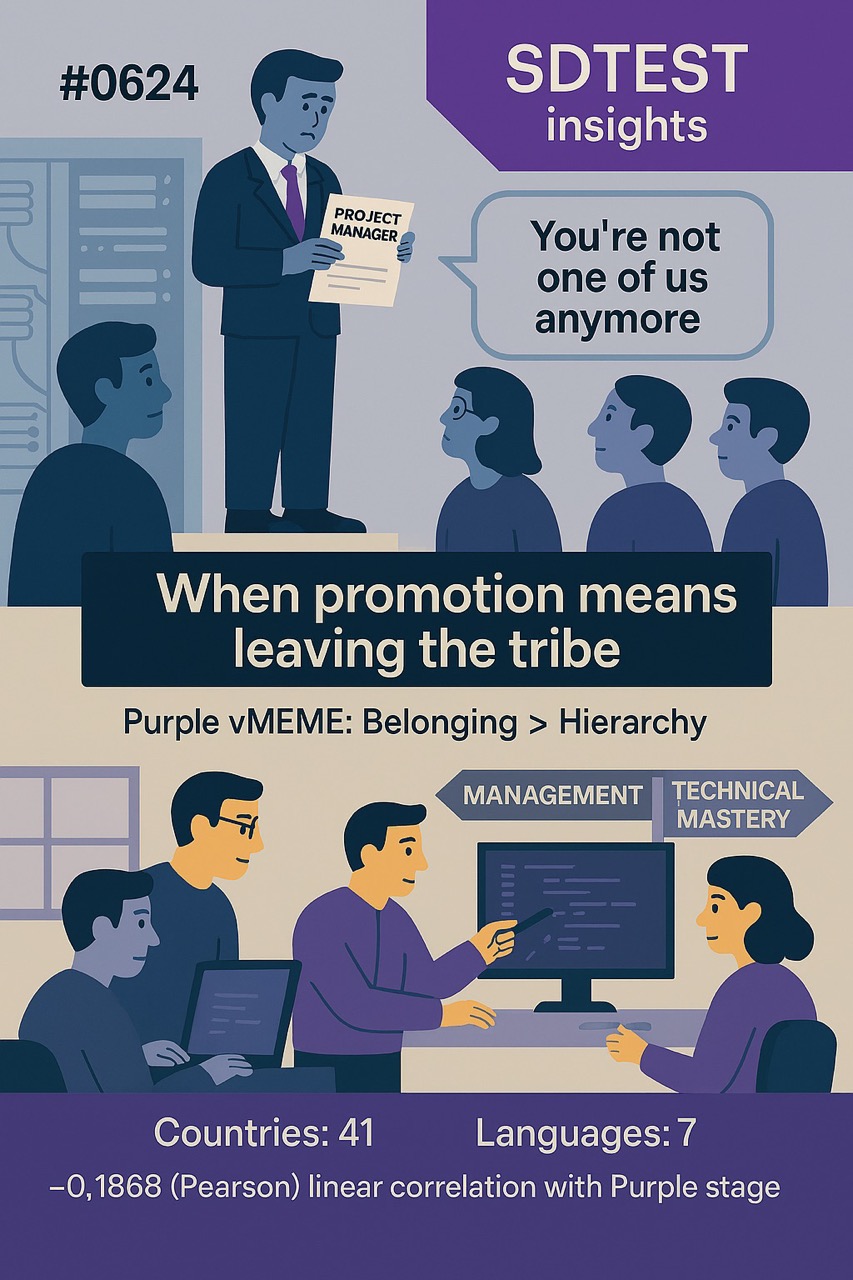
This negative correlation of -0.1868 between Job specialty - Management (product, project, etc.) and the Purple stage offers profound insights when viewed through the lens of the Purple value system:
Organizational Perspective:
Organizations operating within the Purple mindset might interpret this correlation as:
- Validation of their traditional hierarchical structure, where management roles are reserved for chosen elders or spiritual leaders
- Confirmation that their ancestral wisdom about leadership being divinely appointed rather than technically skilled is correct
- Evidence supporting their belief that technical specialists should remain in their designated tribal roles according to ancient customs
These organizations might respond by:
- Maintaining strict separation between technical shamans (IT specialists) and leadership ceremonies reserved for traditional chiefs
- Implementing rituals and taboos that discourage technical workers from crossing into sacred management territories
- Consulting tribal elders and spiritual advisors before allowing any IT specialist to assume management responsibilities
Team Perspective:
Teams operating from a Purple mindset might approach this correlation by:
- Viewing it as an affirmation of their belief that each member has a sacred role determined by ancestral spirits
- Interpreting it as support for maintaining traditional boundaries between the technical medicine makers and tribal leaders
- Seeing it as validation for preserving the mystical separation between those who work with technology magic and those who guide the community
These teams might respond by:
- Conducting ritual ceremonies to bless IT specialists in their technical roles while keeping management as a separate calling
- Encouraging technical members to deepen their craft mastery rather than seeking leadership positions
- Creating sacred spaces and customs that honor both technical expertise and management wisdom as distinct spiritual paths
Individual Perspective:
Individuals aligned with the Purple value system might interpret this correlation as:
- Personal confirmation that their calling as a technical practitioner is their destined tribal role
- Evidence supporting their belief that management requires different spiritual gifts than technical mastery
- Validation of their ancestral understanding that crossing into management might disturb the natural order
These individuals might respond by:
- Seeking guidance from community elders about whether pursuing management aligns with their spiritual destiny
- Focusing on becoming master craftspeople in their technical domain as their sacred contribution
- Viewing management roles as requiring different mystical qualities that may not align with their technical calling
This correlation, viewed through the Purple lens, suggests that those operating at the Purple level may perceive management and technical roles as distinct spiritual callings rather than career progression paths.
The reasons why IT specialists might be less drawn to Management roles in the Purple stage could include:
- Sacred Role Boundaries: Technical work may be seen as a distinct spiritual calling that shouldn't be abandoned for management
- Ancestral Wisdom: Traditional beliefs may dictate that leadership requires different mystical qualities than technical expertise
- Community Harmony: Crossing role boundaries might be viewed as disrupting the natural tribal order established by ancestors
- Ritual Specialization: Each individual may believe they have a predetermined role in the community's spiritual ecosystem
- Elder Reverence: Management may be reserved for those blessed by elders or possessing traditional leadership spirits
This correlation prompts us to consider how traditional value systems influence career path perceptions in modern technical fields. It raises questions about the tension between individual technical mastery and community leadership responsibilities in Purple-dominant cultures.
Ultimately, this correlation highlights the complex interplay between ancestral beliefs, spiritual calling, and professional development. In Purple environments, career progression might be less about ambition and more about fulfilling one's destined role within the sacred community structure.
In our analysis of the poll "Algebra of Conscience" (by Vladimir Lefebvre), we found an intriguing positive linear correlation that warrants closer examination:
0.2368 (Pearson) between A doctor should conceal from a patient that he has cancer in order to relieve his suffering / Strongly agree, and the Red stage.
The critical value of the correlation coefficient for a normal distribution, by William Sealy Gosset (Student), is r = 0.1709. Nevertheless, this positive linear correlation of 0.2368 meets the reliability criteria but does not necessarily imply causation.
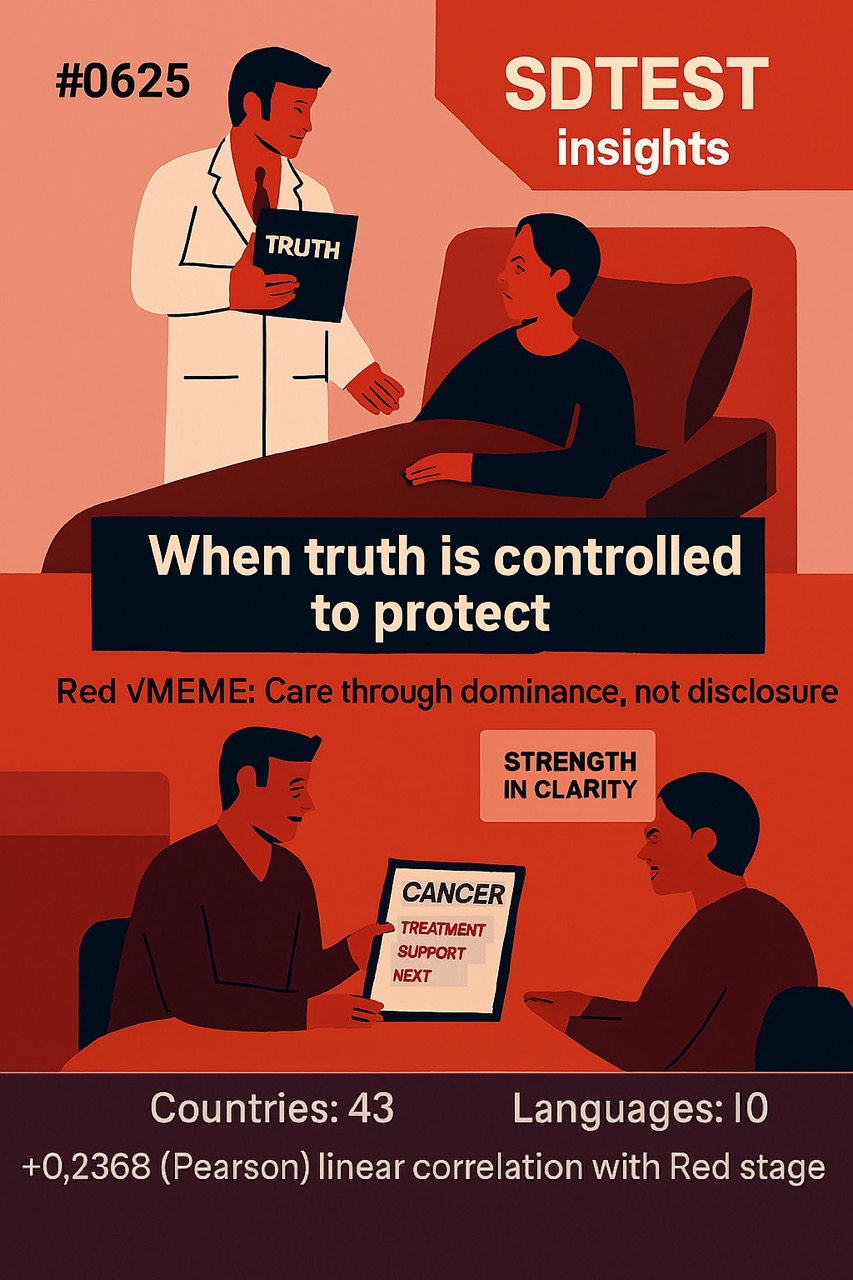
This positive correlation of 0.2368 between "A doctor should conceal from a patient that he has cancer in order to relieve his suffering / Strongly agree" and the Red stage offers compelling insights when viewed through the lens of the Red value system:
Organizational Perspective:
Organizations operating within the Red mindset might interpret this correlation as:
- Validation of their hierarchical power structure, where those in authority decide what information others deserve
- Confirmation that their dominant leadership approach of controlling information flow protects weaker members from harsh realities
- Evidence supporting their belief that strength means making tough decisions for others without their input
These organizations might respond by:
- Implementing information control systems where only the strongest leaders handle difficult truths
- Creating policies that give management complete discretion over what employees need to know about company crises
- Establishing clear power hierarchies where information becomes a weapon and a tool of control
Team Perspective:
Teams operating from a Red mindset might approach this correlation by:
- Viewing it as an affirmation that the strongest team members should shield weaker ones from devastating news
- Interpreting it as support for their belief that leaders must sometimes lie to maintain team morale and performance
- Seeing it as validation for aggressive protection of team members through information manipulation
These teams might respond by:
- Designating alpha members to filter and control what information reaches more vulnerable teammates
- Creating unspoken agreements that tough news should be managed by those with the strength to handle it
- Using information withholding as a demonstration of protective dominance within the team structure
Individual Perspective:
Individuals aligned with the Red value system might interpret this correlation as:
- Personal validation of their instinct to protect others through strategic deception when necessary
- Evidence supporting their belief that showing mercy sometimes requires withholding painful truths
- Confirmation that their impulsive desire to shield loved ones from suffering overrides abstract ethical principles
These individuals might respond by:
- Actively concealing difficult information from family and friends to demonstrate their protective strength
- Viewing truth-telling as weakness when it causes unnecessary pain to others
- Using their power to control information flow as a way of expressing dominance and care simultaneously
This correlation, viewed through the Red lens, suggests that those operating at the Red level may see information control as both a demonstration of power and an expression of protective instinct.
The reasons why people might strongly agree with concealing a cancer diagnosis in the Red stage could include:
- Power as Protection: Using authority and strength to shield others from unbearable psychological pain
- Immediate Gratification: Avoiding the immediate discomfort of witnessing someone's devastating reaction to bad news
- Dominance Display: Demonstrating control over life-and-death information as an expression of superior position
- Impulsive Mercy: Acting on immediate emotional impulse to protect rather than following abstract ethical rules
- Survival Instinct: Believing that harsh truths can destroy fighting spirit and reduce chances of survival
This correlation prompts us to consider how power-focused value systems influence medical ethics and information sharing. It raises questions about the tension between individual autonomy and protective paternalism in Red-dominant cultures.
Ultimately, this correlation highlights the complex interplay between dominance instincts, protective impulses, and ethical decision-making. In Red environments, concealing devastating news might be seen not as deception but as an act of merciful strength - using power to spare others from unbearable suffering while maintaining control over the situation.
In our analysis of the poll "21 skills that pay you forever" (by Jeremiah Teo / 赵汉昇 [1]), we found an intriguing positive linear correlation that warrants closer examination:
0.1534 (Pearson) between the Ability to shut up, listen and learn from others / Moderately Agree and the Blue stage.
The critical value of the correlation coefficient for a normal distribution, by William Sealy Gosset (Student), is r = 0.1109. Nevertheless, this positive linear correlation of 0.1534 meets the reliability criteria but does not necessarily imply causation.
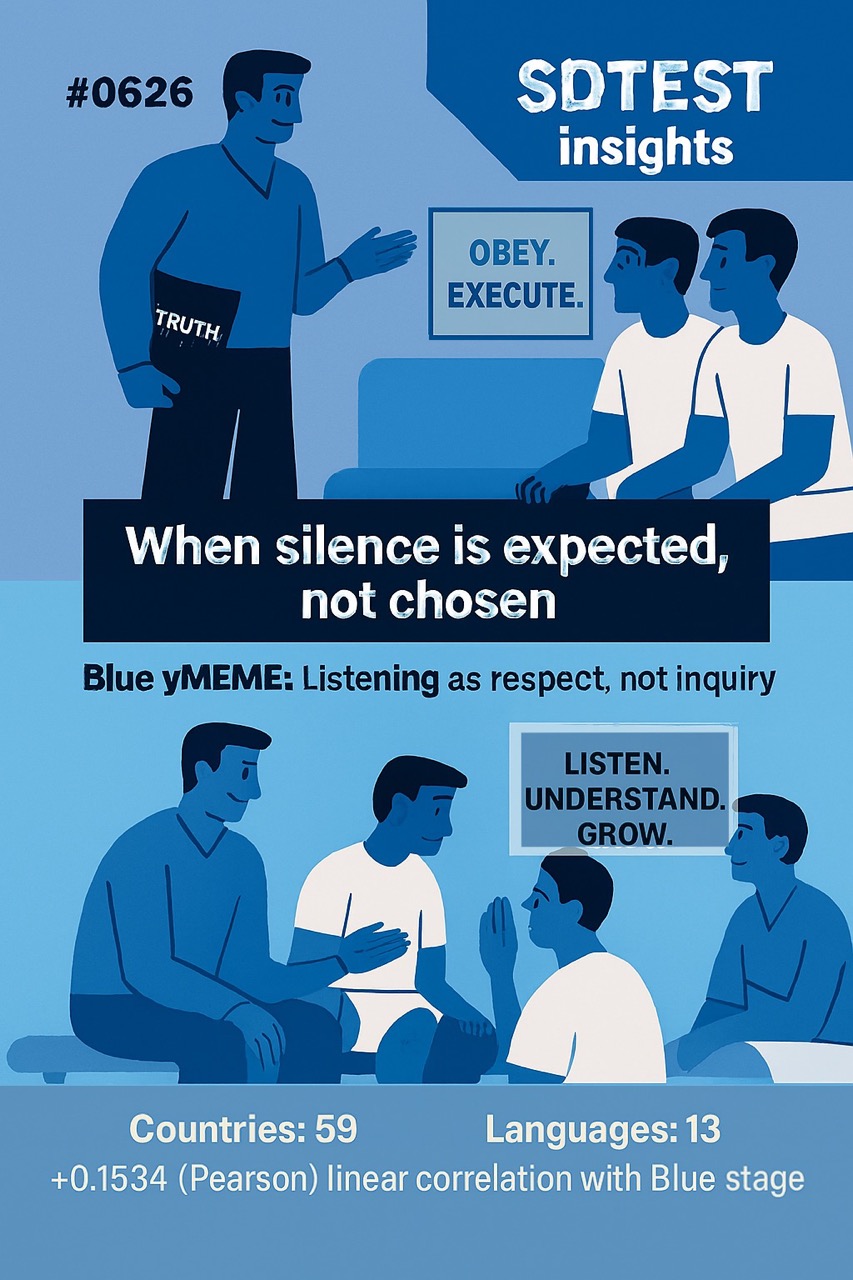
This positive correlation of 0.1534 between "Ability to shut up, listen and learn from others / Moderately Agree" and the Blue stage offers valuable insights when viewed through the lens of the Blue value system:
Organizational Perspective:
Organizations operating within the Blue mindset might interpret this correlation as:
- Validation of their hierarchical structure, where proper listening to superiors and established authorities is fundamental to order
- Confirmation that their disciplined approach to learning from institutional knowledge and established protocols drives success
- Evidence supporting their belief that respectful silence and attentive learning maintain organizational stability and moral order
These organizations might respond by:
- Implementing formal protocols requiring employees to listen respectfully to supervisors and follow established procedures
- Creating structured training programs that emphasize learning from institutional wisdom and proven methodologies
- Establishing clear chains of command where listening to higher authorities is a sacred duty and professional obligation
Team Perspective:
Teams operating from a Blue mindset might approach this correlation by:
- Viewing it as an affirmation of their belief that proper team functioning requires respectful deference to experience and expertise
- Interpreting it as support for maintaining traditional roles where junior members learn from senior colleagues through disciplined observation
- Seeing it as validation for structured communication patterns that preserve hierarchy and ensure orderly knowledge transfer
These teams might respond by:
- Establishing formal mentorship programs where experienced members guide newcomers through established traditions
- Creating structured meeting protocols that ensure proper listening order and respectful knowledge sharing
- Implementing systems that reward team members who demonstrate appropriate humility and willingness to learn from established practices
Individual Perspective:
Individuals aligned with the Blue value system might interpret this correlation as:
- 1. Personal validation of their disciplined approach to learning through respectful listening and proper conduct
- 2. Evidence supporting their belief that moral character includes humility and willingness to receive wisdom from legitimate authorities
- 3. Confirmation that their traditional values of respect, duty, and continuous learning through established channels lead to success
These individuals might respond by:
- Actively seeking guidance from respected mentors, religious leaders, or institutional authorities in their field
- Practicing disciplined listening as both a professional skill and a moral obligation to their community
- Viewing their ability to learn from others as fulfillment of their duty to grow within established frameworks
This correlation, viewed through the Blue lens, suggests that those operating at the Blue level may see listening and learning as both professional competencies and moral imperatives within proper hierarchical structures.
The reasons why people might moderately agree with valuing listening and learning skills in the Blue stage could include:
- Hierarchical Respect: Understanding that proper listening to authorities and experts is essential for maintaining organizational order
- Duty-Based Learning: Viewing continuous learning through established channels as a moral obligation and professional responsibility
- Traditional Wisdom: Recognizing that accumulated institutional knowledge deserves respectful attention and careful study
- Disciplined Growth: Believing that personal development must occur within structured, rule-based frameworks guided by legitimate authorities
- Moral Character: Seeing humility and willingness to learn as fundamental virtues that reflect proper character development
This correlation prompts us to consider how order-focused value systems influence approaches to professional development and interpersonal skills. It raises questions about the balance between individual initiative and respectful deference to established authority in Blue-dominant cultures.
Ultimately, this correlation highlights the complex interplay between moral duty, hierarchical respect, and skill development. In Blue environments, listening and learning abilities might be valued not just as practical skills but as expressions of proper character, institutional loyalty, and commitment to traditional pathways of knowledge acquisition and professional growth.
In our analysis of the poll "Where would be your next most exciting opportunity?", we found an intriguing positive linear correlation that warrants closer examination:
0.1157 (Pearson) between the International Market leader and the Orange stage.
The critical value of the correlation coefficient for a normal distribution, by William Sealy Gosset (Student), is r = 0.0514. Nevertheless, this positive linear correlation of 0.1157 meets the reliability criteria but does not necessarily imply causation.

This positive correlation of 0.1157 between "International Market leader" as the next most exciting opportunity and the Orange stage offers compelling insights when viewed through the lens of the Orange value system:
Organizational Perspective:
Organizations operating within the Orange mindset might interpret this correlation as:
- Validation of their merit-based approach, where ambitious professionals naturally gravitate toward the most successful, data-driven market leaders
- Confirmation that their rational, results-focused culture attracts top talent who understand that market leadership represents optimal career advancement opportunities
- Evidence supporting their belief that scientific management principles and technological innovation create the most desirable work environments
These organizations might respond by:
- Implementing aggressive recruitment strategies that emphasize their market leadership position and growth metrics as key selling points
- Creating performance-based advancement systems that attract goal-oriented individuals seeking measurable career progression
- Investing heavily in cutting-edge technology and analytical tools to maintain their competitive edge and appeal to rational, ambitious professionals
Team Perspective:
Teams operating from an Orange mindset might approach this correlation by:
- Viewing it as an affirmation that high-performing teams naturally seek environments with the greatest potential for measurable impact and success
- Interpreting it as support for their belief that working with market leaders provides optimal learning opportunities and career acceleration
- Seeing it as validation for prioritizing teams that can deliver quantifiable results in competitive, innovation-driven environments
These teams might respond by:
- Actively seeking projects and roles within market-leading organizations to maximize their collective professional development
- Establishing performance metrics and benchmarking systems that align with industry-leading standards and practices
- Creating collaborative networks with other high-performing teams in market-leading companies to share best practices and innovations
Individual Perspective:
Individuals aligned with the Orange value system might interpret this correlation as:
- Personal validation of their rational career strategy focused on joining organizations with proven track records of success and growth
- Evidence supporting their belief that market leaders offer the best opportunities for skill development, networking, and financial advancement
- Confirmation that their analytical approach to career planning correctly identifies optimal professional environments
These individuals might respond by:
- Strategically targeting market-leading companies in their job searches, using data analysis to identify the most successful organizations
- Continuously developing technical and analytical skills that are highly valued by market leaders in their respective industries
- Building professional networks within market-leading companies to gain insights and access to exciting opportunities
This correlation, viewed through the Orange lens, suggests that those operating at the Orange level may see market leaders as logical career destinations that align with their goal-oriented, results-focused worldview.
The reasons why people might find International Market leaders as their next most exciting opportunity in the Orange stage could include:
- Rational Career Optimization: Understanding that market leaders offer the highest probability of career advancement and financial success
- Learning Acceleration: Recognizing that leading companies provide access to cutting-edge technologies, methodologies, and industry expertise
- Measurable Impact: Believing that working for market leaders maximizes the scale and measurability of one's professional contributions
- Competitive Advantage: Seeking environments where they can compete at the highest levels and benchmark themselves against top performers
- Innovation Access: Understanding that market leaders typically invest most heavily in research, development, and technological advancement
This correlation prompts us to consider how achievement-focused value systems influence career decision-making and organizational preferences. It raises questions about the relationship between rational career planning and market dynamics in Orange-dominant professional cultures.
Ultimately, this correlation highlights the complex interplay between individual ambition, analytical thinking, and strategic career optimization. In Orange environments, international market leaders might be viewed not just as employers but as optimal platforms for achieving measurable success, continuous learning, and competitive professional advancement.
In our analysis of the poll "I live thinking about my past, present, or future," we found an intriguing positive linear correlation that warrants closer examination:
0.3620 (Pearson) between the Past and the Green stage (Germany, 3 languages - not German).
The critical value of the correlation coefficient for a normal distribution, by William Sealy Gosset (Student), is r = 0.2731. Nevertheless, this positive linear correlation of 0.3620 meets the reliability criteria but does not necessarily imply causation.

This positive correlation of 0.3620 between "Past" temporal focus and the Green stage among respondents who selected non-German native languages in Germany offers profound insights when viewed through the lens of the Green value system:
Organizational Perspective:
Organizations operating within the Green mindset might interpret this correlation as:
- Validation of their holistic understanding that individuals from diverse cultural backgrounds naturally value their ancestral wisdom and traditional knowledge systems
- Confirmation that their inclusive, systems-thinking approach recognizes how past experiences and cultural heritage contribute to collective organizational wisdom
- Evidence supporting their belief that honoring diverse historical perspectives and cultural narratives strengthens community resilience and sustainability
These organizations might respond by:
- Creating multicultural heritage programs that celebrate and integrate diverse historical perspectives into organizational learning
- Implementing restorative justice approaches that address historical traumas while building inclusive community structures
- Developing support systems that honor the rich cultural past of international community members while fostering collective growth
Team Perspective:
Teams operating from a Green mindset might approach this correlation by:
- Viewing it as an affirmation that team members with diverse cultural backgrounds bring valuable historical wisdom and collective memory to collaborative efforts
- Interpreting it as support for creating healing circles and storytelling spaces that honor past experiences while building team unity
- Seeing it as validation for their belief that understanding historical context and cultural trauma is essential for authentic team cooperation
These teams might respond by:
- Facilitating cultural sharing sessions where team members can honor their heritage and past experiences as sources of collective strength
- Creating safe spaces for processing historical trauma and displacement experiences within supportive team environments
- Developing collaborative projects that weave together diverse cultural narratives and historical perspectives for community benefit
Individual Perspective:
Individuals aligned with the Green value system might interpret this correlation as:
- Personal validation of their deep connection to ancestral wisdom, cultural heritage, and the transformative power of honoring one's roots
- Evidence supporting their belief that reflecting on past experiences—including displacement, struggle, and cultural journey—provides essential healing and growth
- Confirmation that their holistic approach to identity integrates historical experience with present community engagement and future sustainability
These individuals might respond by:
- Engaging in cultural preservation activities and storytelling that honor their heritage while building bridges across communities
- Participating in healing circles and support networks that address historical trauma while fostering collective resilience
- Using their past experiences of displacement and adaptation as wisdom for supporting other community members facing similar challenges
This correlation, viewed through the Green lens, suggests that those operating at the Green level may see past-focused reflection as essential for healing, community building, and sustainable cultural integration.
The reasons why individuals with non-German native languages might focus on the past in the Green stage could include:
- Healing Integration: Using reflection on displacement experiences and cultural heritage as a pathway to holistic healing and community connection
- Collective Memory: Understanding that honoring past struggles and cultural journey strengthens community resilience amid current social challenges
- Trauma Processing: Engaging in past-focused reflection as part of healing from displacement, discrimination, and systemic barriers
- Cultural Preservation: Recognizing that maintaining a connection to historical roots supports both individual identity and collective cultural diversity
- Systems Understanding: Viewing current challenges, including reduced social support and increased community tensions, through the lens of historical patterns and cycles
This correlation prompts us to consider how community-focused value systems influence temporal orientation and cultural integration processes. It raises questions about the relationship between historical consciousness, healing practices, and sustainable community building in diverse societies.
Ultimately, this correlation highlights the complex interplay between cultural identity, collective memory, and community resilience. In Green environments, past-focused reflection might be viewed not as dwelling on difficulties but as essential wisdom-gathering for creating more inclusive, sustainable, and healing-centered communities.
In our analysis of the poll "Why People Resist Change" (by Siobhán McHale [2]), we found an intriguing negative linear correlation that warrants closer examination:
-0.1484 (Pearson) between the Curtailed freedom and the Yellow stage.
The critical value of the correlation coefficient for a normal distribution, by William Sealy Gosset (Student), is r = 0.1073. Nevertheless, this negative linear correlation of -0.1484 meets the reliability criteria but does not necessarily imply causation.
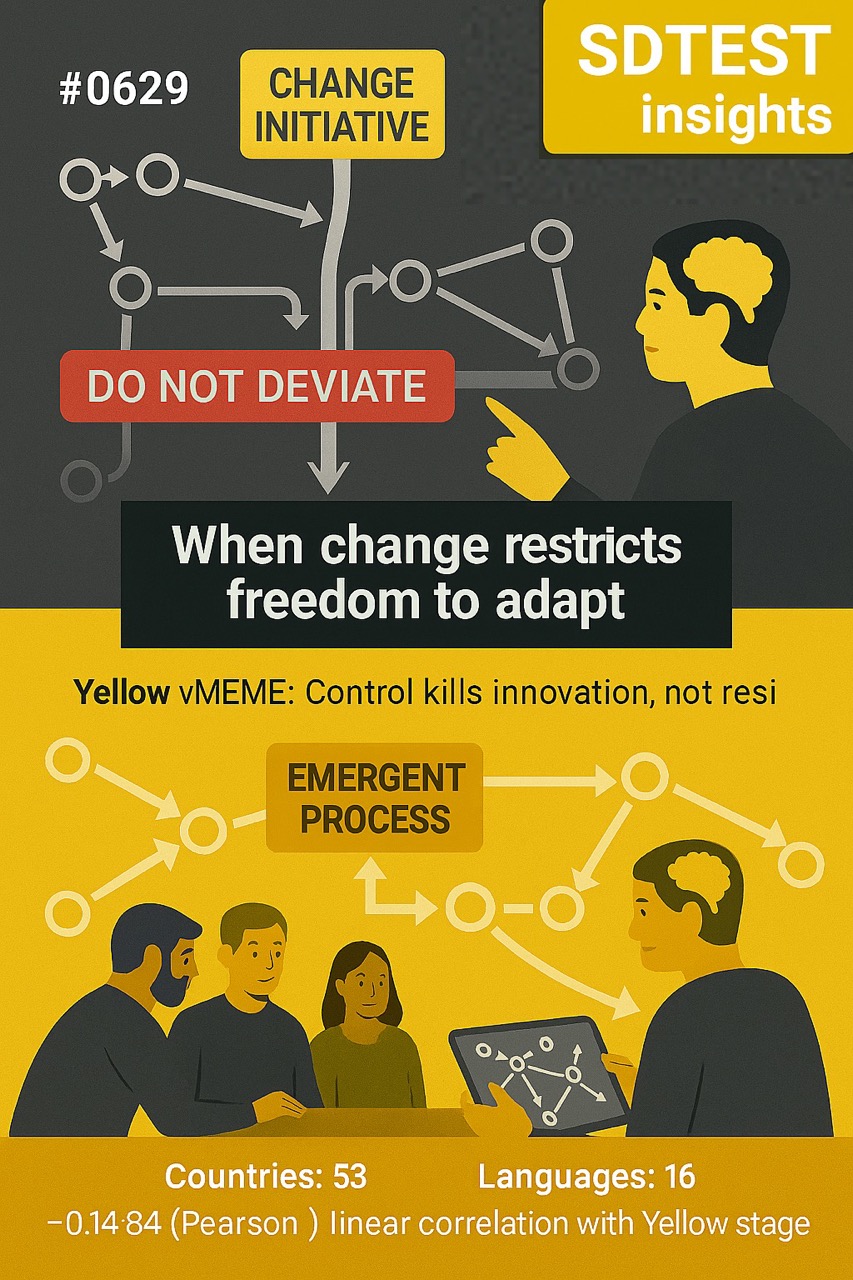
This negative correlation of -0.1484 between "Curtailed freedom" as a reason for resisting change and the Yellow stage offers fascinating insights when viewed through the lens of the Yellow value system:
Organizational Perspective:
Organizations operating within the Yellow mindset might interpret this correlation as:
- Validation of their integrative leadership approach that recognizes freedom and constraint as dynamic, contextual elements rather than absolute binaries
- Confirmation that their systems-thinking framework enables employees to understand how apparent limitations can actually create new possibilities for growth and adaptation
- Evidence supporting their belief that mature organizational consciousness transcends simplistic freedom-versus-control paradigms in favor of nuanced, adaptive responses to change
These organizations might respond by:
- Developing sophisticated change management processes that help employees see constraints as design parameters rather than freedom restrictions
- Creating educational frameworks that demonstrate how systemic boundaries often enable rather than limit creative solutions and personal agency
- Implementing multi-perspectival decision-making systems that reveal how apparent curtailments can unlock previously unseen opportunities for organizational evolution
Team Perspective:
Teams operating from a Yellow mindset might approach this correlation by:
- Viewing it as an affirmation of their capacity to reframe constraints as creative challenges that enhance rather than diminish collective capability
- Interpreting it as support for their integrative approach that sees freedom and structure as complementary forces in effective team dynamics
- Seeing it as validation for their belief that mature teams transcend reactive resistance by understanding the systemic purpose behind apparent limitations
These teams might respond by:
- Facilitating collaborative exploration of how proposed changes create new freedoms while requiring temporary constraint adjustments
- Developing team rituals that celebrate constraint navigation as a form of collective intelligence and adaptive mastery
- Creating learning processes that help team members discover how apparent curtailments often signal opportunities for higher-order functioning and innovation
Individual Perspective:
Individuals aligned with the Yellow value system might interpret this correlation as:
- Personal validation of their developmental capacity to see beyond surface-level freedom concerns toward deeper systemic patterns and possibilities
- Evidence supporting their integrative worldview that recognizes how apparent limitations often catalyze creative breakthrough and expanded capability
- Confirmation of their mature relationship with a change that transcends binary thinking about freedom versus constraint
These individuals might respond by:
- Actively exploring how apparent curtailments in change processes might actually expand their range of effective action and personal growth
- Engaging in perspective-taking exercises that reveal the multidimensional nature of freedom and constraint within complex systems
- Using change situations as opportunities to practice integrative thinking that transforms apparent limitations into creative parameters for innovation
This correlation, viewed through the Yellow lens, suggests that those operating at the Yellow level may have transcended reactive patterns around freedom concerns in favor of sophisticated, systems-aware responses to change.
The reasons why "Curtailed freedom" might not be a primary resistance factor in the Yellow stage could include:
- Systems Awareness: Understanding that constraints and freedoms exist within larger systemic contexts where apparent limitations often enable new possibilities
- Paradoxical Thinking: Recognizing that freedom and constraint are dialectical forces that can enhance rather than oppose each other in complex systems
- Developmental Perspective: Viewing apparent curtailments as natural aspects of growth processes that require temporary constraint navigation for long-term expansion
- Multi-Level Consciousness: Operating from multiple perspectives simultaneously, seeing how constraints at one level often create freedoms at another
- Integration Capacity: Ability to hold seemingly contradictory elements in creative tension rather than experiencing them as problematic conflicts
This correlation prompts us to consider how integrative consciousness influences change perception and adaptation strategies. It raises questions about the relationship between developmental maturity and the ability to respond to systemic transformation in a sophisticated manner.
Ultimately, this correlation highlights the complex interplay between consciousness development, systems thinking, and change adaptation. In Yellow environments, apparent freedom curtailments might be viewed not as threats to resist but as systemic design features that enable higher-order functioning and evolutionary development.
0.2927 (Pearson) between the Sent employees on unpaid vacations and the Turquoise stage (France, four languages).
The critical value of the correlation coefficient for a normal distribution, by William Sealy Gosset (Student), is r = 0.2785. Nevertheless, this positive linear correlation of 0.2927 meets the reliability criteria but does not necessarily imply causation.
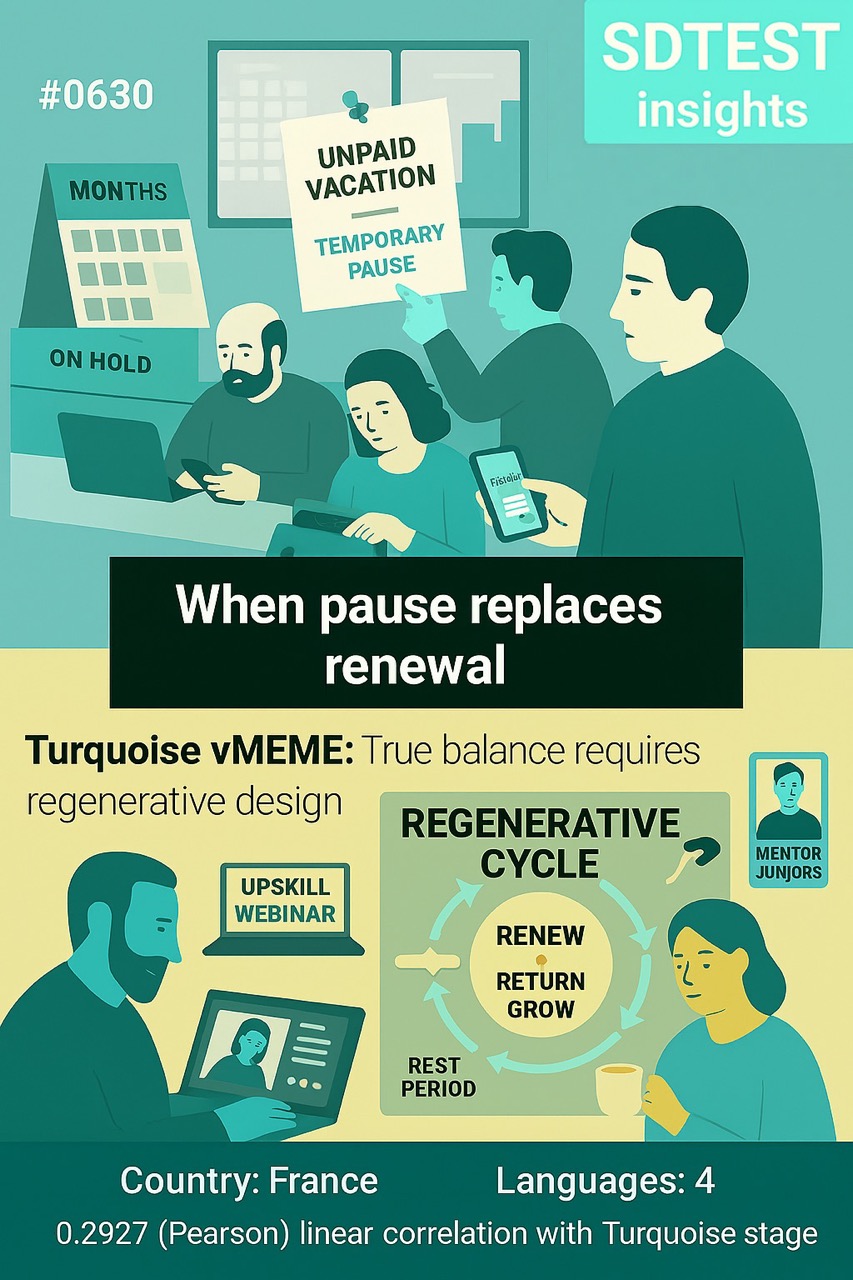
This positive correlation of 0.2927 between "Sent employees on unpaid vacations" and the Turquoise stage among multilingual companies in France offers profound insights when viewed through the lens of the Turquoise value system:
Organizational Perspective:
Organizations operating within the Turquoise mindset might interpret this correlation as:
- Validation of their holistic approach that prioritizes long-term ecosystem sustainability over short-term financial optimization during economic transitions
- Confirmation that their interconnected worldview recognizes unpaid leave as a compassionate alternative to layoffs, preserving the human fabric of their organizational community
- Evidence supporting their belief that conscious business practices must honor both planetary constraints and human dignity amid France's complex economic landscape of inflation, energy costs, and post-pandemic recovery
These organizations might respond by:
- Creating comprehensive support systems during unpaid leave periods, including skill development programs and mental health resources that maintain human connection
- Implementing transparent communication about economic pressures while co-creating sustainable solutions with their multilingual, multicultural workforce
- Developing regenerative business models that view temporary economic contraction as opportunities for deeper organizational evolution and community resilience
Team Perspective:
Teams operating from a Turquoise mindset might approach this correlation by:
- Viewing it as an affirmation of their collective wisdom in choosing shared sacrifice over individual terminations, recognizing the interconnected nature of team wellbeing
- Interpreting it as support for their holistic understanding that unpaid leave can serve as a conscious pause for reflection, skill development, and community strengthening
- Seeing it as validation for their belief that diverse, multilingual teams possess unique resilience and adaptive capacity during systemic economic shifts
These teams might respond by:
- Establishing mutual support networks during unpaid leave periods, sharing resources, and maintaining cultural connections across their diverse linguistic communities
- Creating collaborative learning initiatives that use the pause period for cross-cultural skill sharing and personal development
- Developing team rituals and practices that maintain spiritual and emotional connection despite physical separation and financial constraints
Individual Perspective:
Individuals aligned with the Turquoise value system might interpret this correlation as:
- Personal validation of their integrated understanding that economic challenges are opportunities for deeper life alignment and conscious living exploration
- Evidence supporting their holistic worldview that temporary financial constraint can catalyze spiritual growth and community connection
- Confirmation of their ecological consciousness that recognizes economic cycles as natural rhythms requiring adaptive response rather than resistance
These individuals might respond by:
- Embracing unpaid leave as sacred time for reconnecting with nature, pursuing sustainable living practices, and exploring alternative economic models
- Engaging in community mutual aid networks that transcend monetary exchange, particularly within France's diverse immigrant and multilingual communities
- Using the period for spiritual practice, creative expression, and deepening their understanding of interconnected global systems
This correlation, viewed through the Turquoise lens, suggests that those operating at the Turquoise level may see unpaid leave not as corporate abandonment but as conscious adaptation to larger systemic pressures affecting France's economy.
The reasons why multilingual companies might choose unpaid vacations in the Turquoise stage could include:
- Ecological Awareness: Understanding that France's economic pressures—from energy costs to inflation—reflect larger planetary transitions requiring adaptive rather than exploitative responses
- Systems Integration: Recognizing that multilingual workforces represent valuable cultural ecosystems worth preserving through temporary financial sacrifice
- Compassionate Leadership: Choosing shared responsibility over individual termination, honoring the interconnected nature of organizational community
- Sustainable Timing: Using economic downturns as opportunities for conscious pause, reflection, and regenerative planning aligned with France's sustainability goals
- Evolutionary Perspective: Viewing current economic challenges in France as part of a larger civilizational transition requiring new models of work-life integration
This correlation prompts us to consider how holistic consciousness influences corporate decision-making during economic uncertainty. It raises questions about the relationship between ecological awareness, cultural diversity, and sustainable business practices in post-industrial societies.
Ultimately, this correlation highlights the complex interplay between planetary consciousness, economic adaptation, and cultural preservation. In Turquoise environments, unpaid leave might be viewed not as corporate cost-cutting but as conscious stewardship of both human community and larger ecological systems during France's ongoing economic and environmental transitions.
What insights do you gain from today's correlation? How might we study this relationship more carefully before deducing causation?
We welcome respectful and wise perspectives! Stay tuned every week as we share more results and insights.
After login or registration, free access to the poll results in the FAQ section.
[1] www.linkedin.com/in/jeremiah-teo-charisma-business-coach
[2] www.linkedin.com/in/mchalesiobhan
2025.09.21
FearpersonqualitiesprojectorganizationalstructureRACIresponsibilitymatrixCritical ChainProject Managementfocus factorJiraempathyleadersbossGermanyChinaPolicyUkraineRussiawarvolatilityuncertaintycomplexityambiguityVUCArelocatejobproblemcountryreasongive upobjectivekeyresultmathematicalpsychologyMBTIHR metricsstandardDEIcorrelationriskscoringmodelGame TheoryPrisoner's Dilemma
valerii kosenko
ထုတ်ကုန်ပိုင်ရှင် SaaS SDTEST®
Valerii သည် 1993 ခုနှစ်တွင် လူမှုသင်ကြားရေး-စိတ်ပညာရှင်တစ်ဦးအဖြစ် အရည်အချင်းပြည့်မီခဲ့ပြီး ထိုမှစတင်၍ ပရောဂျက်စီမံခန့်ခွဲမှုတွင် သူ၏အသိပညာကို အသုံးချခဲ့သည်။
Valerii သည် မဟာဘွဲ့နှင့် ပရောဂျက်နှင့် ပရိုဂရမ်မန်နေဂျာ အရည်အချင်းစစ် 2013 ခုနှစ်တွင် ရရှိခဲ့သည်။ သူ၏ Master အစီအစဉ်တွင်၊ သူသည် Project Roadmap (GPM Deutsche Gesellschaft für Projektmanagement e. V.) နှင့် Spiral Dynamics တို့နှင့် ရင်းနှီးလာခဲ့သည်။
Valerii သည် V.U.C.A ၏ မသေချာမရေရာမှုကို စူးစမ်းရေးသားသူဖြစ်သည်။ စိတ်ပညာတွင် Spiral Dynamics နှင့် သင်္ချာကိန်းဂဏန်းများကို အသုံးပြုထားသော အယူအဆနှင့် နိုင်ငံတကာ စစ်တမ်း ၃၈ ခု။








